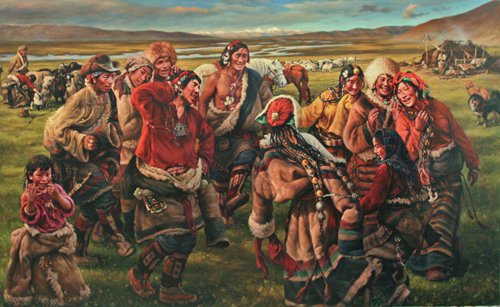pei zhuangxin
裴庄欣 ,中国美术家协会、 [1] 西藏自治区美术家、摄影家协会会员。西藏美术馆筹建委员会特聘外籍专家。 1956年四川成都出生 ,1971年下乡到西藏昌都,1978年考入四川美术学院油画系,毕业后重返西藏工作,1989年获 “美中文化教育交流基金会”
Pei Zhuangxin Photo: He Keyao/GT

Dance on the Grass by Pei Zhuangxin Photo: Courtesy of Pei Zhuangxin
When Pei Zhuangxin first went to the Tibet Autonomous Region in the early 1970s at the age of 15, he never imagined that he would one day become a celebrated artist. He also never expected that this remote plateau would remain a continual theme for his creations throughout his artistic career.
Pei, the well-known Chinese American painter who has had studios in both New York and Beijing, is known for his Tibetan-themed works. His representative works, such as Nomads Family and Dance on the Grass, are widely known and have been highly praised in fine art circles. Painting Tibet for more than half a century, he uses his brushes to express his deep love for the place that is intimately tied with his youthful memories of the 1970s and 1980s.
Eternal memories
"To me, Tibet is not only a source of artistic creation, but a place that carries unique values and memories. Drawing it has already become an essential part of my life," Pei told the Global Times.
Pei started to work as an auto mechanic in Tibet's Changdu area in 1971 after graduating from middle school. Like many young people at the time, known as "Zhi Qing" or educated youth, Pei decided to devote himself to the development of the country's border areas. However, his talent for painting distinguished him from other colleagues in the auto shop and ended up changing his life.
"First, I just helped paint posters for local events and gradually I was given the opportunity to work as a full-time painter. I feel grateful to Tibet since it kicked off my artistic pursuits," Pei said, talking about his early years living on the plateau.
The beautiful natural landscape and local people's lives provided him rich sources of inspiration. In 1978, he enrolled in the Sichuan Fine Arts Institute, but returned to Tibet to work in a museum in Lhasa after he graduated in 1982.
During the next seven years, Pei entered a productive heyday, producing many well-known realist artworks based on real life in Tibet, including Wearing a Red Cassock, In the Jokhang Temple and Nomads Family, the latter of which was published in a Hong Kong art magazine, a rarity for a mainland artist at the time. Some of his works are now part of art institution collections in the US, Japan, Germany and France.
Pei's fascination with the unique culture and religion of the region is vividly reflected in his work. Rich colors, subtle usage of light and the exploration of life and religion, happiness and love are common features in his works.
Pei's deep connection with Tibet isn't limited to his artistic works. As someone deeply in love with the highlands, Pei also established the region's first fine art training class and first art gallery, the Tibet Gallery, while he worked in Lhasa. Many of his former students have become well-known artists in their own right in Chinese art circles.
"Some of them made it to the professional art academies later and we still keep contact for one reason: common interest and love in Tibet," said Pei.
Surprising development
Pei went to the US for further his art education during the late 1980s, but Tibet remained a touchstone in his artistic creations. During lonely nights or hard days living far away from his motherland, putting his memories of Tibet on canvas was a source of comfort and spiritual strength.
"I feel that Tibet has already become an abstract existence that has integrated itself into my creations, consciously and subconsciously," he said.
Over the past 10 years, Pei's work has reached another stage, one that is a combination of realism and expressionism. Tibetan elements have penetrated into each stroke of his paintings, which are free from specific concrete images or real scenes. Wild use of colors and imagination have injected new life into his art.
Over the past five decades of painting Tibet, Pei has been deeply impressed by the "astonishing changes and development" the region, and China as a whole, has experienced since the country's opening up and reform began in 1978.
"It is a miracle. No country other than China could have developed this fast," Pei commented.
He remembered that when he left Tibet for the US in the late 1980s, a bike was something rarely seen in Lhasa, while now the place is a big city with three major highways encircling it, which to him is something that he never imagined possible at the time.
Together with the rapid economic development of the country, the art market has also flourished.
"People in China are paying more and more attention to art and artists and Chinese artists overseas are willing to come back," Pei said, noting that tolerance and acceptance of diversity and freedom in art has been greatly enhanced in China, which in turn has helped the Chinese art market to become more prosperous than in the West.
来源:环球时报 2018/5/31

摄影:何 ke yao/ / GT

裴庄欣“草原上的锅庄”照片:裴庄欣提供
当裴庄欣第一次在二十世纪七十年代初,到西藏自治区时,十五岁时,他从未想到他有朝一日会成为一位着名的艺术家。他也从未预料到,这个偏远的高原在他的艺术生涯中始终是他创作的一个持续主题。在纽约和北京都有工作室的着名华裔美籍画家裴先生以他的西藏主题作品而闻名。他的代表作品,如游牧民族和草地上的舞蹈,广为人知,并在美术界受到高度评价。
在西藏绘画半个多世纪以来,他用画笔表达了对与20世纪70年代和80年代的青春记忆密切相关的地方的深深热爱。永恒的回忆
“对我来说,西藏不仅是艺术创作的源泉,而且是一个具有独特价值和记忆的地方,绘制它已经成为我生活中不可或缺的一部分,”裴告诉环球时报。1971年,裴开始在中学毕业后在西藏昌都地区当过汽车修理工。像当时许多被称为“知青”或知青的年轻人一样,裴决定致力于该国边境地区发展。
然而,他的绘画才能使他与汽车修理场中的其他同事区分开来,并最终改变了他的生活。“首先,我帮助为当地活动画海报,并逐渐让我有机会成为一名全职画家,我对西藏自从开始了我的艺术追求感到感激,”裴说,谈到他早年的生活在高原上。美丽的自然景观和当地人民的生活为他提供了丰富的灵感来源。
1978年,他考入四川美术学院,1982年毕业后回到西藏拉萨的展览馆工作。在接下来的七年中,裴进入了一个富有成效的鼎盛时期,制作了许多以西藏现实生活为基础的着名现实主义艺术作品,其中包括戴红衣大昭寺和游牧民族,后者在香港出版艺术杂志,这是当时大陆艺术家的稀罕物。
他的一些作品现在是美国,日本,德国和法国艺术机构收藏的一部分。他的工作生动地体现了裴对该地区独特文化和宗教的迷恋。丰富的色彩,微妙的光线使用以及对生活和宗教,幸福与爱的探索是他作品中的共同特征。
裴与西藏的深厚联系不仅限于他的艺术作品。作为深爱高原的人,裴先生在拉萨工作期间,还创办了该地区的第一个美术培训班和第一个美术馆,西藏画廊。他以前的许多学生已经成为艺术界的知名艺术家。“他们中的一些人稍后将它交给了专业艺术院校,我们仍然保持联系的原因之一是:西藏的共同利益和爱,”裴说。令人惊讶的发展
裴在80年代后期赴美国进行艺术教育,但西藏仍是他艺术创作的试金石。在远离祖国的孤寂的夜晚或艰难的日子里,把他对西藏的记忆放在画布上,是舒适和精神力量的源泉。“我觉得西藏已经成为一个抽象的存在,有意识地和潜意识地融入到我的创作中,”
他说。在过去的十年中,裴的作品已经到了另一个阶段,即现实主义和表现主义相结合的阶段。西藏元素渗透到他的绘画的每一个中风中,这些绘画都没有具体的具体图像或真实场景。对颜色和想象力的狂野运用为他的艺术注入了新的活力。
在过去五十年的绘画西藏事件中,裴先生对中国“惊人的变化与发展”给予了深刻的印象,并且自1978年中国改革开放以来,经历了整个中国的经历。“这是一个奇迹,除了中国之外,没有哪个国家能够快速发展,”裴先生评论道。
他记得,当他在20世纪80年代末离开西藏去美国时,自行车也是拉萨缺乏的东西,而现在这个地方是一座大城市,有多条主要公路围绕着它,对他而言,这是他从未想象过的事情。时间。
随着国家经济的快速发展,艺术市场也蓬勃发展。“中国人越来越关注艺术和艺术家,海外的中国艺术家愿意回来”,裴表示,中国的艺术多元化,自由的宽容和接受度已经大大提高,帮助中国艺术市场比西方更加繁荣。
报纸头条:高端艺术 张贴在: 艺术 , 文化
Zhuangxin Pei Pei Zhuangxin




